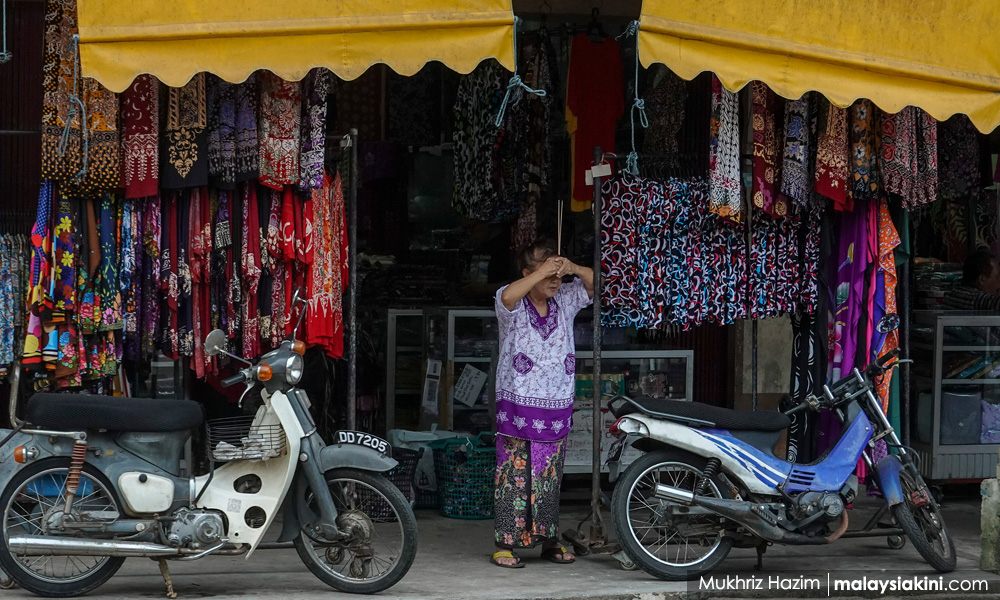
James Chai
COMMENT | To understand why Kelantan, Malaysia’s poorest state in terms of income per capita, ranked so high (fifth) on the Malaysia Happiness Index, we need to first look at a strange statistic.
In 1991, an average man in Malaysia lived for 69 years. In the next 25 years, the country’s social and economic progress created more opportunities for healthcare, education, and jobs, pushing the national life expectancy to 72.7 years.
Kelantan’s male populous, however, continued to live only for 69.2 years, throwing it a generation’s progress behind the rest.
For years, nobody understood why Kelantanese men died so young.
Journalist Aidila Razak made an investigation. Was it because the Kelantanese eat more sugar? They are, after all, the only people in Malaysia who add sugar to their roti canai.
But the numbers didn’t add up. Kelantan is only ranked eighth when it comes to diabetes.
Was it because they have the lowest income? Maybe. At RM3,079, the Kelantanese has the lowest median household income in Malaysia.
But if we plot a graph of household income and life expectancy, it is not clear that low household income was the main cause.
In 2016, Dr Noran Hairi of Universiti Malaya came up with a reliable answer. She took the map of Malaysia and plotted different shades of brown based on the levels of deprivation.
The browner the area, the more socio-economically deprived. Then she drew circles on each area to represent how many years were lost; the larger the circle, the more likely the population is to die young. What she found was shocking.
Dark brown shades and large blue circles were heavily concentrated on the east coast of Kelantan and Terengganu. Some circles were so large they almost cover the entire area.
COMMENT | To understand why Kelantan, Malaysia’s poorest state in terms of income per capita, ranked so high (fifth) on the Malaysia Happiness Index, we need to first look at a strange statistic.
In 1991, an average man in Malaysia lived for 69 years. In the next 25 years, the country’s social and economic progress created more opportunities for healthcare, education, and jobs, pushing the national life expectancy to 72.7 years.
Kelantan’s male populous, however, continued to live only for 69.2 years, throwing it a generation’s progress behind the rest.
For years, nobody understood why Kelantanese men died so young.
Journalist Aidila Razak made an investigation. Was it because the Kelantanese eat more sugar? They are, after all, the only people in Malaysia who add sugar to their roti canai.
But the numbers didn’t add up. Kelantan is only ranked eighth when it comes to diabetes.
Was it because they have the lowest income? Maybe. At RM3,079, the Kelantanese has the lowest median household income in Malaysia.
But if we plot a graph of household income and life expectancy, it is not clear that low household income was the main cause.
In 2016, Dr Noran Hairi of Universiti Malaya came up with a reliable answer. She took the map of Malaysia and plotted different shades of brown based on the levels of deprivation.
The browner the area, the more socio-economically deprived. Then she drew circles on each area to represent how many years were lost; the larger the circle, the more likely the population is to die young. What she found was shocking.
Dark brown shades and large blue circles were heavily concentrated on the east coast of Kelantan and Terengganu. Some circles were so large they almost cover the entire area.

When you’re so deprived, you’ve lost all hope
Deprivation goes beyond just income. It asks about the quality of the house (brick or plank, bedrooms), drinking water and toilet facilities, education, employment, cars, and variables like whether they own a washing machine and refrigerator.
The reason this is more reliable is that it accounts for the surrounding infrastructure that the government creates.
If you are sick and there are no buses or roads to the clinic that is 20 minutes away, you are more deprived than a person whose house is just five minutes from three clinics.
Today, the number of hospitals, health clinics, and schools in Kelantan, on a per 1,000 people basis, is still among the lowest in the country. But it is not just the number of facilities; it is also whether they are accessible to locals.
A clinic may be only 5km away, but the lack of roads and public transport means that the journey there is arduous. The queue and income cost means that it is better to just try to heal at home.
Aidila argued that lack of access, rather than the fear of modern medicine, may be the reason why half of the Kelantanese cancer patients trust alternative treatments instead.
If you see that the muddy road outside your house hasn’t been fixed for over two decades, you do not hope that one day a clinic will miraculously appear in your community.
When you hear your relatives in Kuala Lumpur visited a new shopping mall in their area, you do not for once think that the same would be found in Kelantan.
When nearly 30 percent of the people in your state still do not have access to clean piped water, your perspective on hope is very different.
Therein lies the context that we need to understand the Malaysia Happiness Index.
Nobel Laureate Amartya Sen once said that people who live in great misfortune with little hope may get more happiness over the little things they have.
But we must not confuse this happiness with an improvement in well-being.
A person who has been deprived for decades may now “lack the courage to desire much” because hope has disappointed them many times before.
Is Kelantan model state we want?
Therefore, it was painfully hypocritical to hear Kelantan Deputy Menteri Besar Mohd Amar Abdullah proudly proclaim that the Malaysia Happiness Index of Kelantan is a testament to the good work the PAS government has done.

Kelantan Deputy Menteri Besar Mohd Amar Abdullah
All this while Kelantan remains the state with the highest concentration of poor households, second-highest poverty incidence, third-lowest GDP contribution and chart-topping social ills.
Due to the lack of jobs and opportunities in Kelantan, 250,000 youths have fled the state to other economically prosperous places like Selangor – a figure equivalent to nearly 15 percent of the Kelantan population.
Amar’s own constituency of Panchor has the lowest number of hospitals per 1,000 people in entire Malaysia. Health clinics, piped water, schools, police and fire stations are all significantly lower than the national median.
Is this truly a model state we want to emulate for Malaysia?
Five years ago, Amar offered an explanation for Kelantan’s lack of progress that is both comical and chilling. He said that while Kelantan lags behind other states, this was ”deliberate”, almost like an economic philosophy.
PAS could have developed Kelantan into a Selangor if it wanted to, he said, but it preferred the slow pace because they were afraid Kelantanese could not catch up.
In other words, deprivation is justified because it is beneficial to the people. Do it long enough and the people will stop hoping, and soon, they will even be happy with what they have.
It doesn’t matter if 30 percent of the people still do not have clean piped water at home. They can wait a bit longer.
What’s the rush? They’re so happy, can’t you tell?
JAMES CHAI is a visiting fellow at the Iseas-Yusof Ishak Institute. He also blogs at www.jameschai.com.my and can be reached at jameschai.mpuk@gmail.com
All this while Kelantan remains the state with the highest concentration of poor households, second-highest poverty incidence, third-lowest GDP contribution and chart-topping social ills.
Due to the lack of jobs and opportunities in Kelantan, 250,000 youths have fled the state to other economically prosperous places like Selangor – a figure equivalent to nearly 15 percent of the Kelantan population.
Amar’s own constituency of Panchor has the lowest number of hospitals per 1,000 people in entire Malaysia. Health clinics, piped water, schools, police and fire stations are all significantly lower than the national median.
Is this truly a model state we want to emulate for Malaysia?
Five years ago, Amar offered an explanation for Kelantan’s lack of progress that is both comical and chilling. He said that while Kelantan lags behind other states, this was ”deliberate”, almost like an economic philosophy.
PAS could have developed Kelantan into a Selangor if it wanted to, he said, but it preferred the slow pace because they were afraid Kelantanese could not catch up.
In other words, deprivation is justified because it is beneficial to the people. Do it long enough and the people will stop hoping, and soon, they will even be happy with what they have.
It doesn’t matter if 30 percent of the people still do not have clean piped water at home. They can wait a bit longer.
What’s the rush? They’re so happy, can’t you tell?
JAMES CHAI is a visiting fellow at the Iseas-Yusof Ishak Institute. He also blogs at www.jameschai.com.my and can be reached at jameschai.mpuk@gmail.com

"Five years ago, Amar offered an explanation for Kelantan’s lack of progress that is both comical and chilling. He said that while Kelantan lags behind other states, this was ”deliberate”, almost like an economic philosophy.
ReplyDeletePAS could have developed Kelantan into a Selangor if it wanted to, he said, but it preferred the slow pace because they were afraid Kelantanese could not catch up."
Comment - it speaks to the hypocrisy of the PAS state government and the blind and foolish belief by the Kelantanese in the said government.
And to think this Amar fellow sounds very proud and arrogant! That's PAS' islam for you.
Ignorance makes downtrodden people searching for happy al-Jannah after they r dead!
ReplyDelete